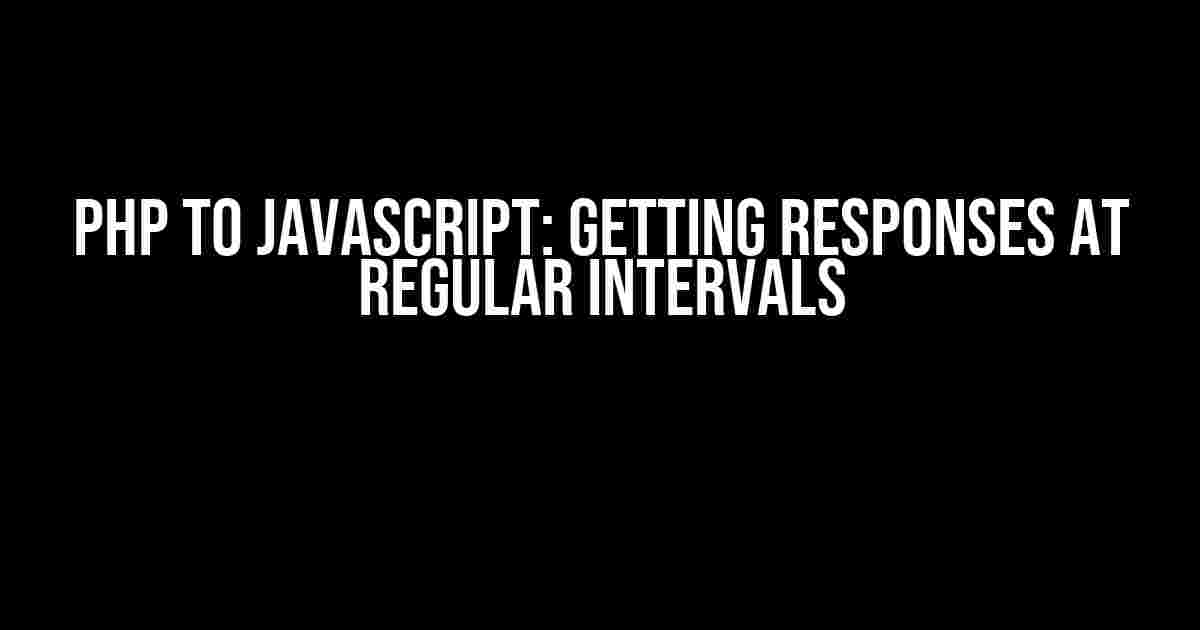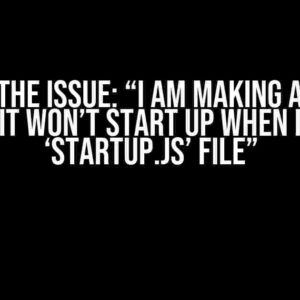Welcome to our comprehensive guide on getting responses from PHP to JavaScript at regular intervals! Are you tired of dealing with laggy user experiences and sluggish data updates? Well, buckle up, because we’re about to take your web development skills to the next level.
Why Do We Need PHP to JavaScript Communication?
In today’s web development landscape, PHP and JavaScript are two of the most popular programming languages used for building robust and dynamic web applications. PHP is a server-side language that excels at handling complex business logic, data storage, and retrieval, while JavaScript is a client-side language that’s perfect for creating interactive and responsive user interfaces.
The problem arises when we need to communicate between these two languages to update data in real-time. Imagine a live chat application where users expect instant updates when someone sends a new message. Without seamless PHP to JavaScript communication, your application would be as good as dead.
Understanding the Basics of PHP and JavaScript Communication
Before we dive into the main topic, let’s quickly review how PHP and JavaScript communicate.
PHP: The Server-Side Language
PHP is a server-side language that runs on a web server, typically Apache or Nginx. When a user requests a PHP page, the server executes the PHP script, and the output is sent back to the user’s browser.
JavaScript: The Client-Side Language
JavaScript, on the other hand, is a client-side language that runs on the user’s browser. It’s used to manipulate the Document Object Model (DOM) and create interactive elements like animations, effects, and event listeners.
AJAX: The Bridge Between PHP and JavaScript
AJAX (Asynchronous JavaScript and XML) is a technique that allows JavaScript to communicate with PHP (or any other server-side language) without reloading the entire page. It’s the backbone of modern web development, enabling us to send HTTP requests to the server and receive responses in real-time.
Getting Responses at Regular Intervals Using PHP and JavaScript
Now that we’ve covered the basics, let’s focus on getting responses from PHP to JavaScript at regular intervals. We’ll explore three methods to achieve this:
Method 1: Polling
Polling is a simple technique where JavaScript sends a request to PHP at regular intervals using the `setInterval()` function. PHP then responds with the latest data, and JavaScript updates the UI accordingly.
// JavaScript code
function fetchUpdates() {
$.ajax({
url: 'get_updates.php',
type: 'GET',
success: function(data) {
console.log(data);
// Update the UI with the latest data
}
});
}
setInterval(fetchUpdates, 5000); // Fetch updates every 5 seconds
Note that polling can be resource-intensive, especially if you’re dealing with high-traffic applications. It’s essential to optimize your PHP script and consider caching to reduce the load on your server.
Method 2: Long Polling
Long polling is an optimized version of traditional polling. Instead of sending a new request every x seconds, JavaScript sends a single request to PHP, which holds the connection open until new data is available. Once PHP responds, JavaScript updates the UI and sends another request to repeat the process.
// JavaScript code
function fetchUpdates() {
$.ajax({
url: 'get_updates.php',
type: 'GET',
success: function(data) {
console.log(data);
// Update the UI with the latest data
fetchUpdates(); // Send another request
}
});
}
fetchUpdates(); // Initialize the long polling process
Long polling reduces the number of requests sent to PHP, making it a more efficient solution than traditional polling. However, it still has its limitations, particularly when dealing with high-latency networks.
Method 3: WebSockets
WebSockets are a bi-directional communication channel between the client (JavaScript) and server (PHP). Once a WebSocket connection is established, PHP can push updates to JavaScript in real-time, eliminating the need for polling or long polling.
// JavaScript code
var ws = new WebSocket('ws://example.com/php_script.php');
ws.onmessage = function(event) {
console.log(event.data);
// Update the UI with the latest data
};
ws.onopen = function() {
console.log('Connected to the WebSocket server');
};
use Ratchet\MessageComponentInterface;
use Ratchet\ConnectionInterface;
use Ratchet\Http\HttpServer;
use Ratchet\WebSocket\WsServer;
class MyWebSocketHandler implements MessageComponentInterface {
protected $server;
public function __construct(WsServer $server) {
$this->server = $server;
}
public function onOpen(ConnectionInterface $conn) {
// Handle new connection
}
public function onMessage(ConnectionInterface $from, $msg) {
// Push updates to connected clients
foreach ($this->server->connections as $connection) {
$connection->send($msg);
}
}
public function onClose(ConnectionInterface $conn) {
// Handle connection closure
}
public function onError(ConnectionInterface $conn, \Exception $e) {
// Handle errors
}
}
$server = new HttpServer(new MyWebSocketHandler(new WsServer($server)));
$server->listen(9000, ‘0.0.0.0’);
Note that WebSockets require a more complex setup and may not be suitable for all use cases. However, they provide the most efficient and scalable solution for real-time communication between PHP and JavaScript.
Best Practices and Considerations
When implementing PHP to JavaScript communication, keep the following best practices and considerations in mind:
- Optimize your PHP script for performance and caching to reduce server load.
- Use JSON encoding to transfer data between PHP and JavaScript.
- Implement security measures to prevent cross-site scripting (XSS) and cross-site request forgery (CSRF) attacks.
- Consider using a message queuing system like RabbitMQ or Apache Kafka for scalable and fault-tolerant communication.
- Test your implementation thoroughly to ensure seamless communication and error handling.
Conclusion
Getting responses from PHP to JavaScript at regular intervals is a crucial aspect of modern web development. By understanding the basics of PHP and JavaScript communication, and implementing the right technique for your use case (polling, long polling, or WebSockets), you can create a more responsive and engaging user experience.
Remember to follow best practices, optimize your code, and consider security measures to ensure a scalable and reliable solution. Happy coding!
| Method | Description | Pros | Cons |
|---|---|---|---|
| Polling | Sends requests to PHP at regular intervals | Easy to implement, suitable for simple applications | Resource-intensive, can lead to server overload |
| Long Polling | Holds the connection open until new data is available | More efficient than polling, suitable for real-time applications | Can still be resource-intensive, may not work with high-latency networks |
| WebSockets | Establishes a bi-directional communication channel | Most efficient solution, suitable for real-time communication | Requires complex setup, may not be suitable for all use cases |
This article has covered the fundamental concepts and techniques for getting responses from PHP to JavaScript at regular intervals. By applying these techniques and best practices, you can create a more seamless and engaging user experience in your web applications.
Here are 5 Questions and Answers about “PHP to Javascript: Getting responses at regular intervals” with a creative voice and tone:
Frequently Asked Question
Get the inside scoop on how to fetch responses from PHP to JavaScript at regular intervals!
How do I send requests from JavaScript to PHP at regular intervals?
You can use JavaScript’s built-in `setInterval()` function to send requests to your PHP script at regular intervals. This function takes two arguments: the function to be executed and the time interval (in milliseconds) at which it should be executed. For example: `setInterval(sendRequest, 5000);` would send a request to your PHP script every 5 seconds.
What’s the best way to receive responses from PHP in JavaScript?
The best way to receive responses from PHP in JavaScript is by using XMLHttpRequest or the Fetch API. These methods allow you to make HTTP requests to your PHP script and receive responses in the form of JSON data, which can then be parsed and processed in your JavaScript code.
How do I handle errors when sending requests from JavaScript to PHP?
When sending requests from JavaScript to PHP, you should always include error handling mechanisms to catch any potential errors that may occur. This can be done using try-catch blocks in your JavaScript code, as well as by checking the response status code and error messages returned by your PHP script.
Can I use jQuery to simplify the process of sending requests from JavaScript to PHP?
Yes, you can use jQuery to simplify the process of sending requests from JavaScript to PHP. jQuery provides a shorthand method called `ajax()` that allows you to make HTTP requests to your PHP script and receive responses in a concise and readable way.
How do I ensure that my PHP script is responding to requests from JavaScript at regular intervals?
To ensure that your PHP script is responding to requests from JavaScript at regular intervals, you can use a combination of server-side and client-side techniques. On the server-side, you can use PHP’s `sleep()` function to pause execution for a specified amount of time before responding to the request. On the client-side, you can use JavaScript’s `setInterval()` function to send requests to your PHP script at regular intervals.





